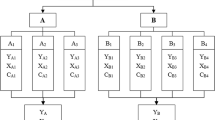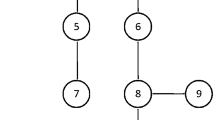Abstract
In the aftermath of the Great Recession of the first decade of this century, we have witnessed an important increase in the number of bank mergers and acquisitions. One of the most important problems faced after a merger is the reduction of the branch network, eliminating redundant branches and adapting the capacity of the resulting network in order to accommodate the demand. This problem becomes even more complex when the uncertainty in the way that the market will react to the restructuring is considered. In this work, we present a stochastic capacitated branch restructuring problem, formulated as a two-stage recourse stochastic programming model. It takes into account the size of the shuttered branches, the existence of competitors, and the uncertainty in the demand’s response. We propose three alternative versions of our formulation that model different ways in which the different stages of the restructuring may be carried out. The model’s performance is tested on 25 alternative settings designed on an extension of Swain’s network. The results show that the banks may obtain important benefits if the necessary changes in the service capacity are carried out after the information about the market’s reaction is available.



Similar content being viewed by others
Notes
A unit of waiting area space is typically considered to be equal to 2 m\(^2\), and the size of a batch (the number of customers that can be accommodated in such area) varies between 4 and 6 individuals.
Notice that the physical service capacity, \(\overline{a}_i\), is usually a legal safety constraint; the architectural features of the building impose a natural limit, \(e_i\), on any potential increase in the branch’s waiting area. On the other hand, the virtual service capacity, \(\overline{b}_i\), is related to the number of employees working on the branch and it is fixed by the institution.
Here and in the next version, we use the notational convention that variables which are directly determined by scenario \(\omega \) are expressed as \(f\left( \omega \right) \); whereas variables affected by the scenario only through a third \(f\left( \omega \right) \) variable, are expressed as \(f^\omega \).
Church and Meadows (1979) showed that, if the set of nodes in a network is augmented by a set of points which lie on the links of the initial nodes, called network intersection points, then the solution to a covering problem, in which the set of candidate points is restricted to this augmented set, will contain the same number of facilities than the problem where the planner is allowed to locate the facilities anywhere in the network. An equivalent result was found for the p-median problem in Church and Meadows (1977).
All these values were calibrated based on real data and respect the underlying proportions between the different figures.
Notice that this will not always be the case as the first stage changes in service capacities, conducted in versions 1 and 3, can lead to different closing decisions.
Notice that, even though there seems to be an exception for branches 4 and 17, the actual Manhattan distance between those branches is larger than \(d^r\).
References
Bell, J., Griffis, S., Cunningham, W, I. I. I., & Eberlan, J. (2011). Location optimization of strategic alert sites for homeland defense. Omega, 39(2), 151–158.
Bhaumic, P. (2010). Optimal shrinking of the distribution chain: The facilities delocation decision. International Journal of Systems Science, 41, 271–280.
Birge, J., & Louveaux, F. (2010). Introduction to stochastic programming. New York: Springer.
Boufounou, P. (1995). Evaluating bank branch location and performance: A case study. European Journal of Operational Research, 87, 389–402.
Brown, J., Lee, E., & Burnet, C. (2012). Global retail banking. Key trends and implications for retail banking real state. Technical report. Jones Lang LaSalle.
Bruno, J., & Anderson, P. (1982). Analytical methods for planning educational facilities in an era of declining enrolments. Socio-Economic Planning Sciences, 16(3), 395–405.
Church, R., & ReVelle, C. (1974). The maximal covering location problem. Papers in Regional Science, 32(1), 101–118.
Church, R., & Meadows, M. (1977). Results of new approach to solving the p-median problem with maximum distance constraints. Geographycal Analysis, 9, 364–378.
Church, R., & Meadows, M. (1979). Location modeling utilizing maximum service distance criteria. Geographycal Analysis, 11, 358–379.
Church, R., & Murray, A. (1993). Modeling school utilization and consolidation. Journal of Urban Planning and Development, 119(1), 23–28.
Cinar, N. (2009). A decision support model for bank branch location selection. International Journal of Mechanical, Industrial Science and Engineering, 3(12), 26–31.
Daskin, M. (1995). Network and Discrete Location. New York: Wiley Interscience.
Davis, S. (2000). Bank Mergers. Lessons for the Future. Wiltshire: Palgrave Macmillan.
Diamond, J., & Wright, J. (1987). Multiobjective analysis of public school consolidation. Journal of Urban Planning and Development, 113(1), 1–18.
Escudero, L. F., & Salmerón, J. (2005). On a fix-and-relax approach for large scale resources constrained project scheduling. Annals of Operations Research, 140(1), 163–188.
Escudero, L., Garń, M., Merino, M., & Pérez, G. (2009). A general algorithm for solving two-stage stochastic mixed 01 first-stage problems. Computers and Operations Research, 36(9), 2590–2600.
Escudero, L. F., Garín, A., Merino, M., & Pérez, G. (2010). An exact algorithm for solving large-scale two-stage stochastic mixed integer problems: Some theoretical and experimental aspects. European Journal of Operational Research, 204, 105–116.
Escudero, L., Garín, M., Pérez, G., & Unzueta, A. (2013). Scenario cluster decomposition of the Lagrangian dual into stage stochastic mixed 0-1 optimization. Computers and Operations Research, 40(1), 362–377.
Fiordelisi, F. (2009). Mergers and acquisitions in European banking. Hampshire: Palgrave MacMillan.
French, S., Leyshon, A., & Meek, S. (2013). The changing geography of British bank and building society branch networks, 2003-20112. Technical report, University of Nottingham.
Fuentelzas, L. (2006). Multipoint competition, strategic similarity and entry into geographic markets. Strategic Management Journal, 27(5), 477–499.
Guastaroba, G., & Speranza, M. G. (2012). Kernel search for the capacitated facility location problem. Journal of Heuristics, 18(6), 877–917.
Hansen, P., Mladenović, N., & Pérez, D. (2001). Brito. Variable neighborhood decomposition search. Journal of Heuristics, 7(4), 335–350.
Levi, R., Shmoys, D. B., & Swamy, C. (2012). Lp-based approximation algorithms for capacitated facility location. Mathematical Programming, 131(1), 365–379.
Mergers and Acquisitions Review. (2013). Financial advisors. Full Year 2012, Technical report. Thomson Reuters.
Miliotis, P., Dimopoulou, M., & Giannikos, I. (2002). A hierarchical location model for locating bank branches in a competitive environment. International Transactions in Operational Research, 9(5), 549–565.
Min, H. (1989). A model-based decision support system for locationg banks. Information and Management, 17(4), 207–215.
Min, H., & Melachrinoudis, E. (2001). The three-hierarchical location-allocation of banking facilities with risk and uncertainty. International Transactions in Operational Research, 8, 381–401.
Monteiro, M., & Fontes, D. (2006). Locating and sizing bank-branches by opening, closing or maintaining facilities. In Operations research proceedings, 2005 (Vol. VIII, pp. 303–308).
Morrison, P., & O’Brien, R. (2001). Bank branch closures in New Zealand: The application of a spacial interaction model. Applied Geography, 21, 301–330.
ReVelle, Ch. (1986). The maximum capture or “sphere of influence” location problem: Hotelling revisited on a network. Journal of Regional Science, 26(2), 343–358.
ReVelle, Ch., & Swain, R. (1970). Central facilities location. Geographical Analysis, 2(1), 30–42.
ReVelle, Ch., Murray, A., & Serra, D. (2007). Location models for ceding market share and shrinking services. Omega, 35(5), 533–540.
Ruiz-Hernández, D., Delgado-Gómez, D., Escudero, L., & López-Pascual, J. (2012). Delocacion models for closing and resizing redundant branches during bank restructuring. In 25th European conference on operational research, Vilnius, Lithuania, July, 2012.
Sridharan, R. (1995). The capacitated plant location problem. European Journal of Operational Research, 87(2), 203–213.
Sun, M. (2012). A tabu search heuristic procedure for the capacitated facility location problem. Journal of Heuristics, 18(1), 91–118.
Tang, L., Jiang, W., & Saharidis, G. (2013). An improved Benders decomposition algorithm for the logistics facility location problem with capacity expansions. Annals of Operations Research, 210(1), 165–190.
Thanh, P., Bostel, N., & Péton, O. (2008). A dynamic model for facility location in the design of complex supply chains. International Journal of Production Economics, 113(2), 678–693.
Toregas, C., Swain, R., ReVelle, C., & Bergman, L. (1971). The location of emergency service facilities. Operations Research, 19, 1363–1373.
Wang, Q., Batta, R., Bhadury, J., & Rump, C. (2003). Budget constrained location problem with opening and closing of facilities. Computers and Operations Research, 30(13), 2047–2069.
Wang, X., Zhang, X., Guo, L., Liu, X., Li., T., Dong, J., et al. (2012). Branch reconfiguration practice through operations research in industrial and commercial bank of China. Interfaces, 7(1), 33–44.
Yuan, Y., & Sen, S. (2009). Enhanced cut generation methods for decomposition-based branch and cut for two-stage stochastic mixed-integer programs. INFORMS Journal on Computing, 21(3), 480–487.
Acknowledgments
The authors acknowledge with gratitude Prof. Laureano Escudero for his fruitful contribution in early stages of this article.
Author information
Authors and Affiliations
Corresponding author
Rights and permissions
About this article
Cite this article
Ruiz-Hernández, D., Delgado-Gómez, D. The stochastic capacitated branch restructuring problem. Ann Oper Res 246, 77–100 (2016). https://doi.org/10.1007/s10479-014-1730-3
Published:
Issue Date:
DOI: https://doi.org/10.1007/s10479-014-1730-3




